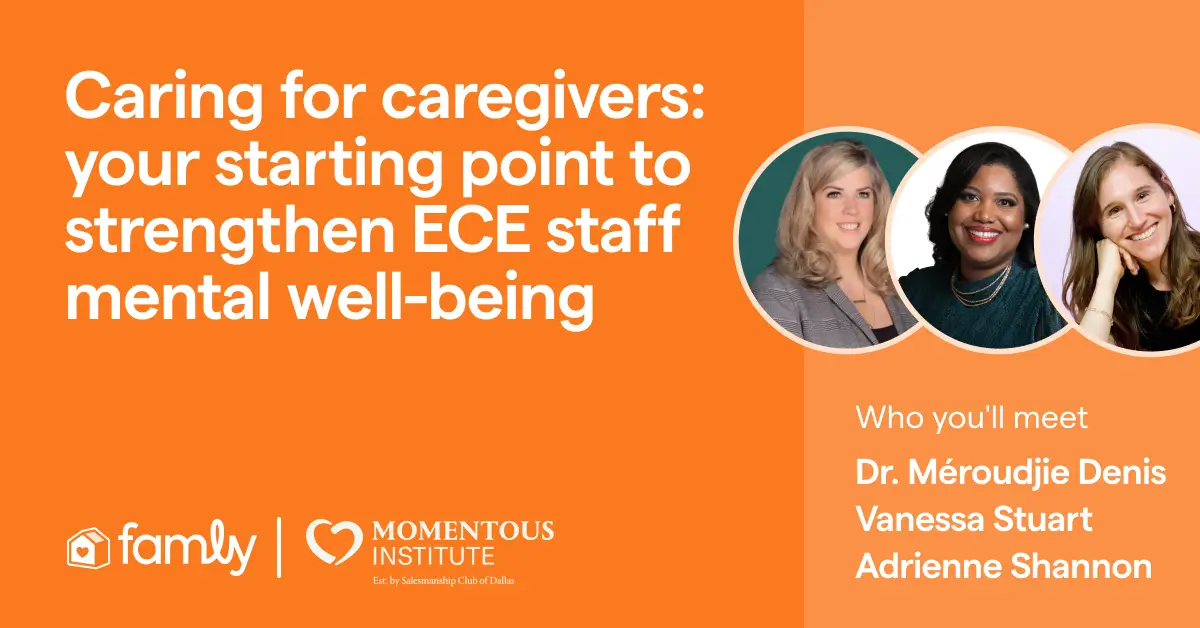settings
children
With Famly since

At Famly, we believe in the power of play — not just for children, but for the grown-ups who care for them too.
In those early years, every interaction matters. Whether it’s counting pom-poms, navigating big feelings, or curling up for storytime, the magic of early education happens when educators are present, engaged, and grounded.
But we also know it comes at a cost.
The emotional labor of caring for young children — day in and day out — requires constant energy, patience, and attention. And when educators are burned out or stretched too thin, that ability to be fully present starts to fade.
That’s why we’re also advocates of playtime for caregivers outside of the classroom - whatever playtime (or recharging) means to them. Going for a run, traveling, watching an HBO series, grabbing brunch with a friend, or painting. Because we’ve seen first-hand: the quality of care in a center starts with the wellbeing of staff
Burnout in early childhood education isn’t breaking news. Famly recently ran a survey and data confirmed: ECE staff are overwhelmed, stretched thin, and working over time. (Nearly 90% of childcare staff work overtime at least once a week!)
So, what does it really take to support the mental well-being of early educators? I sat down with experts Dr. Méroudjie Denis and Mrs. Vanessa Stuart from Momentous Institute to find out.
Together, they shared a simple explanation of the science behind stress, the physiological reactions and what early childhood professionals can realistically do to prioritize their mental well-being – even in the few minutes in between knee scrapes, fallen block towers, and storytime.
Now, a recap of the conversation
First, I’ll share what Dr. Denis and Mrs. Stuart said about the biology of stress and why it seems to be so prevalent in early childhood educators. Then, I promise to end on a positive note with solutions that you can literally start right this moment.
Why is burnout so prevalent in early childhood education?
1. Caregivers are wired for connection
When we say not just anyone could work in early childhood, we mean it. It takes a rare kind of patience, empathy, and emotional attunement to support young children through their earliest years - especially when those children are still learning how to communicate their needs and manage big feelings.
Therefore, it’s not a huge surprise “so many early childhood educators are caretakers by nature.” They’re the ones who step up, say yes, and consistently put others first. It's an incredible trait, but also can become a vulnerability.
“Saying “yes” often feels like it's part of their - not only part of their job - but even part of their identity. But, saying “yes” to everything is not a sign of commitment. It's often a sign of depletion. And constantly saying “yes” when you need to say “no” is one of the fastest ways to get to burnout.”
The big ideas
This isn’t just because you struggle to say “no” because you don’t want to upset someone. But it actually becomes conditioned and a part of your brain processing:
“Over time, our brains start to internalize this and start to create relational templates around this. So what we start to say is, ‘if I say yes, I'm safe. If I say no, I'm selfish or I'm disappointing or I will make the adult angry with me.’”
That guilt you feel when setting boundaries? That’s your nervous system responding to what it thinks is a threat. So when you're feeling burnt out, saying “yes” feels safer, even though every bone in your body is begging you to rest. And if that feels familiar, you’re not alone. You’re just human.
2. Your time for self-reflection is limited
The discussion also explored how staff can feel annoyed, irritated or helpless by a certain child’s behavior - or what Dr. Denis and Mrs. Stuart referred to as a trigger.
First and foremost, “being triggered does not make you a bad teacher. It makes you a human.” It really is a neurobiological response, not a failure.
“Being triggered does not make you a bad teacher. It makes you a human.”
Dr. Denis broke down the biology of a trigger: "the amygdala — our internal alarm system — interprets emotional overwhelm as a threat. And once that 'fight, flight, or freeze' response is activated, the thinking brain (the prefrontal cortex) goes offline. That’s why we might snap, shut down, or spiral."
Oftentimes, the trigger isn’t really about the child or that specific moment, but instead, about something that has happened to us in our past.
So when we’re triggered, we need to self-reflect, and ask, “Why did that child spilling all the crayons all over the floor just bother me so much?” Burnout grows when we ignore these responses, or triggers. When we don’t take a moment to understand, reflect, or recover, that frustration or anger or sadness can fester.
It’s not your fault that self-reflection isn’t exactly what you’re thinking of when you’re rushing to clean up before anyone slips and falls. As educators, your attention and energy is in constant demand. Your busy days make you more prone to burnout. This is something educators should keep in mind. So try to deliberately take at least two minutes later in the day to reflect on the moments that triggered you and try to understand why.
3. The essentials are the first to go
Mental wellness doesn’t require a spa day (although I will literally never say no to a deep tissue massage!). It starts with the basics: breath, nutrition, hydration, movement, and being in nature. It’s not glamorous, but it works.
In a profession as demanding as ECE, these essentials are often the first things to fall off the to-do list. Mrs. Stuart summarized it perfectly when she said, “Sometimes the problem is we know it, but we don't do it.”
And science does show that these “small things” really do a lot in regulating the nervous system and reducing stress. For example, the 5-7-8 breathing method (inhale for 5 seconds, hold for 7, exhale for 8) helps reset the body’s stress response in real time.

Practical ways to relieve stress when your time and energy is limited
Chronic stress doesn’t stay in your head. It lives in your body. It shows up in fatigue, muscle tension, brain fog, stomach issues, and immune suppression. You’re not just “tired.” You’re likely depleted in every system — physical, emotional, cognitive, and relational. And when you’re constantly in “go mode”, your nervous system forgets how to turn off.
So that’s why we need to focus on solutions that help reduce stress in all aspects. So now, let’s dive into some ways to do that.
Dr. Denis and Mrs. Stuart were both incredibly clear on this point during our webinar: you don’t have to overhaul your life to start feeling better. Micro-moments, quick resets, and basic human needs add up.
So that’s the first good news: the same way stress builds layer by layer, healing can happen the same way.
The second good news: The solutions Dr. Denis and Mrs. Stuart shared are doable — even with a classroom full of toddlers, and only 5 minutes in between activities.
Microbreaks matter more than you think
One of the most practical takeaways from the webinar was this: Recovery doesn’t require hours. Just 30 seconds can make a difference.
Dr. Denis emphasized the power of microbreaks — tiny pockets of time to recalibrate your nervous system. Step into the hallway and take a breath. Splash cold water on your face. Stretch your shoulders. Put your feet flat on the floor and exhale.
And if you’re in a co-teaching environment? Use that structure to your advantage. Mrs. Stuart recommended “tap outs,” or short, agreed-upon moments where one teacher can step away and regroup, while the other holds the space. These intentional pauses are what she calls “micro-recoveries,” and they help prevent full-scale burnout from building.
Apps aren’t just for “doomscrolling”
Okay, so yes, doomscrolling on TikTok might not be the most effective way to unwind. But there are apps that really do help with mindfulness, stress regulation, and tracking emotional health — especially for educators who might not have time (or energy) to do this manually.
Here are a few mentioned during the webinar:
- Breathe, Calm, Headspace, Balance
These all offer guided breathing exercises, meditations, and body scans — many with free versions. Mrs. Stuart pointed out that even just a two-minute breathing session can help reset your nervous system after a stressful moment in the classroom. - How We Feel (for Apple Watch)
This one stood out as a favorite of Mrs. Stuart’s. It monitors your heart rate variability and gives you insights into how your body is responding to stress — even if you don’t consciously realize it. “If I notice I’m showing up in the red a lot,” she shared, “I know I need to take action.” - Apple Health’s “State of Mind” Feature
Built into the iPhone’s Health app, this tool prompts you to check in with your mood and log what might be contributing to it. Over time, it gives you a bigger-picture view of your mental state and the patterns that emerge — whether it’s Sunday scaries or that one parent meeting every Thursday.
These tools should not replace real time off or professional help — but they can help staff build awareness, slow down in the moment, and get back into their bodies when the classroom chaos starts to pile up.

Journaling
Doesn’t have to be a long thoughtful piece! Dr. Denis suggested quick journaling prompts that take just one minute. After a tough moment, jot down:
- What happened?
- How did I feel (emotionally and physically)?
- What did I need at that moment?
It can be on a post-it, in a notes app, or in a dedicated tool like the Starting Point Journal from Momentous Institute.
When you can’t control the triggers, focus on the glimmers
We talk a lot about triggers. But what about glimmers?
Triggers are an automatic neurobiological reaction to a threat, and focusing on glimmers can help us find safety during those moments.
Glimmers are those small moments that make you feel safe, calm, or connected — even just for a second. It might be the smell of your favorite coffee, a walk through the park, a picture of a loved one on your desk, a cozy blanket on the couch, or a song that makes you smile. They don’t have to be big. But they do need to be intentional.
Plus, as Mrs. Stuart explained,
“You can even layer your glimmers — like layering your jewelry. If you love a certain scent, music, and a warm bath, do all three together to enhance the effect.”
Pro tip: Keep a list of those glimmers, and what fuels you close by and visible at all times so they are there even “when you're too tired to think and…you’ve reached decision fatigue because you've been making decisions for, you know, 15 three-year-olds all day long and you just can't think of anything else.”
“You don't have to prove that you're being productive in order to deserve pleasure and to deserve rest. Joy isn't a reward, right? It's a right.”
Leaders: your calm is contagious
Finally, and maybe most importantly — this work isn’t just for staff. Leaders set the tone.
As Dr. Denis reminded us, “Your stress and your calm get mirrored.” If you’re always skipping breaks, answering emails at 9 PM, or apologizing for taking PTO, your team will follow suit.
Create predictable check-ins. Encourage breaks. Put visual reminders around the center (a “5-7-8 Breathing” poster in the staff room, or a “Mood Check-In” clipboard by the clock-in station). And remind your staff: We care about how you feel here. You matter.
The three most important takeaways:
1. Rest is a right, not a reward
“You don't have to prove that you're being productive in order to deserve pleasure and to deserve rest. Joy isn't a reward, right? It's a right.”
We can’t keep waiting until the to-do list is finished to give ourselves permission to rest. In ECE, that to-do list never ends. So we have to build in rest as a professional standard — not a perk.
2. Pair rest and joy with where you’re at
I enjoy going to the gym, and that’s a way for me to destress and recharge. But sometimes, when I’m really stressed, I feel it strongly in my body. I’m achy, tired, and low energy. So, while going to do a workout might sound like a good idea to release some stress, in reality, it isn't. In fact, it would probably push my body even more over its limit. Instead, I need to focus on finding something that will bring me enjoyment at the energy level that I’m at.
“If you're too tired to do much, don't fight it. Don't say, like, you know, my plan was to go run three miles after work and now I'm sitting on the couch and I'm beating myself up all week for it, right? So instead pair it with something that's enjoyable. And pair that with your rest. While you're on the couch, light a candle, wrap yourself in a soft blanket. Watch something that is going to generally make you laugh or move you.”
This is what Dr. Denis refers to as “nourishing rest” instead of “passive rest.”
My solution? Paint by numbers. It’s been the best reset for me lately.
3. The idea of “nourishing rest”
If we want staff to truly reset, we have to give them more than surface-level breaks. That means not just lunch in the staff room, or a “quiet” day before the fall term. It means real time off — to rest, to regulate, and to give their bodies the chance to reset at the cellular level. Their brains need it, their hearts need it, and your program thrives when your staff is well.

Want to hear more?
This really is just the surface of the conversation I had with Dr. Denis and Mrs. Stuart. Their expertise, their insights, their strategies, and the way they simplify the science behind it all is impossible to summarize.
I highly recommend you watch the full webinar replay here:
Caring for Caregivers: Strengthening Staff Mental Health with Momentous Institute
And don’t forget to share the free Mental Health Toolkit with your staff, too. Because behind every thriving child is a grown-up who’s regulated, valued, and given time to truly rest.
Free downloadable Early Childhood resources
Explore our library of longer-form books, guides and editable templates - all free to download.
Explore free resources








%20(2).png)
